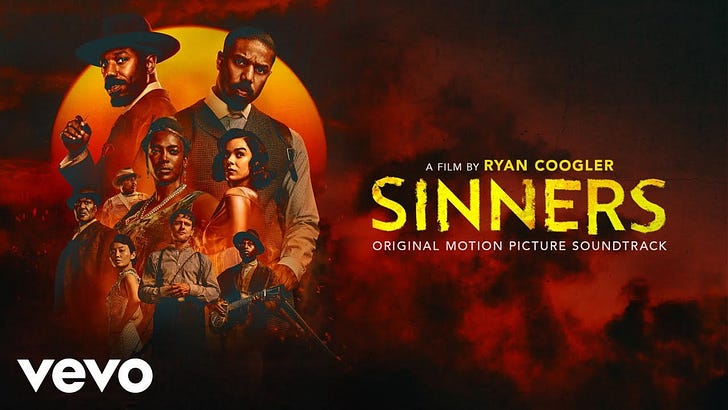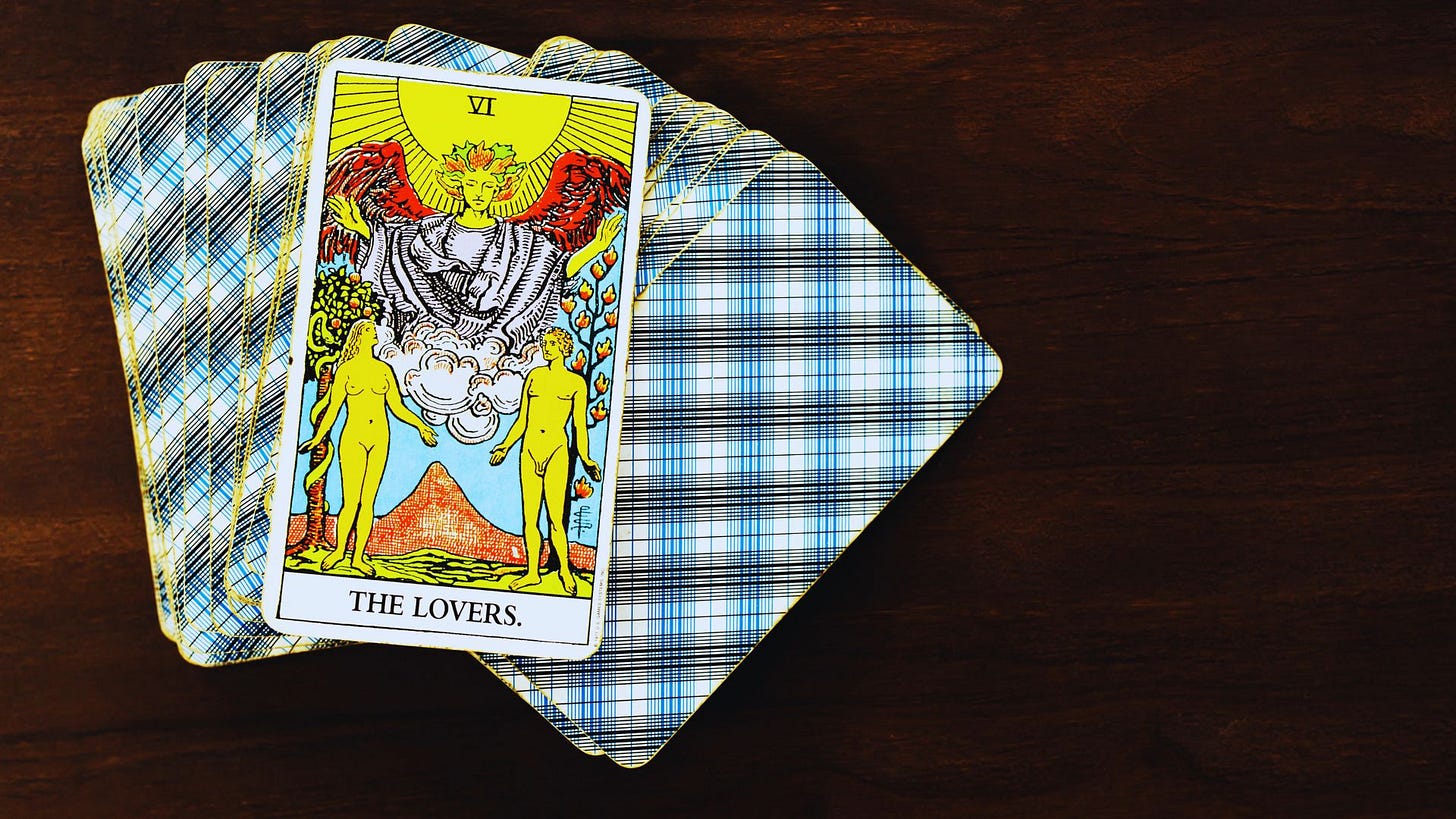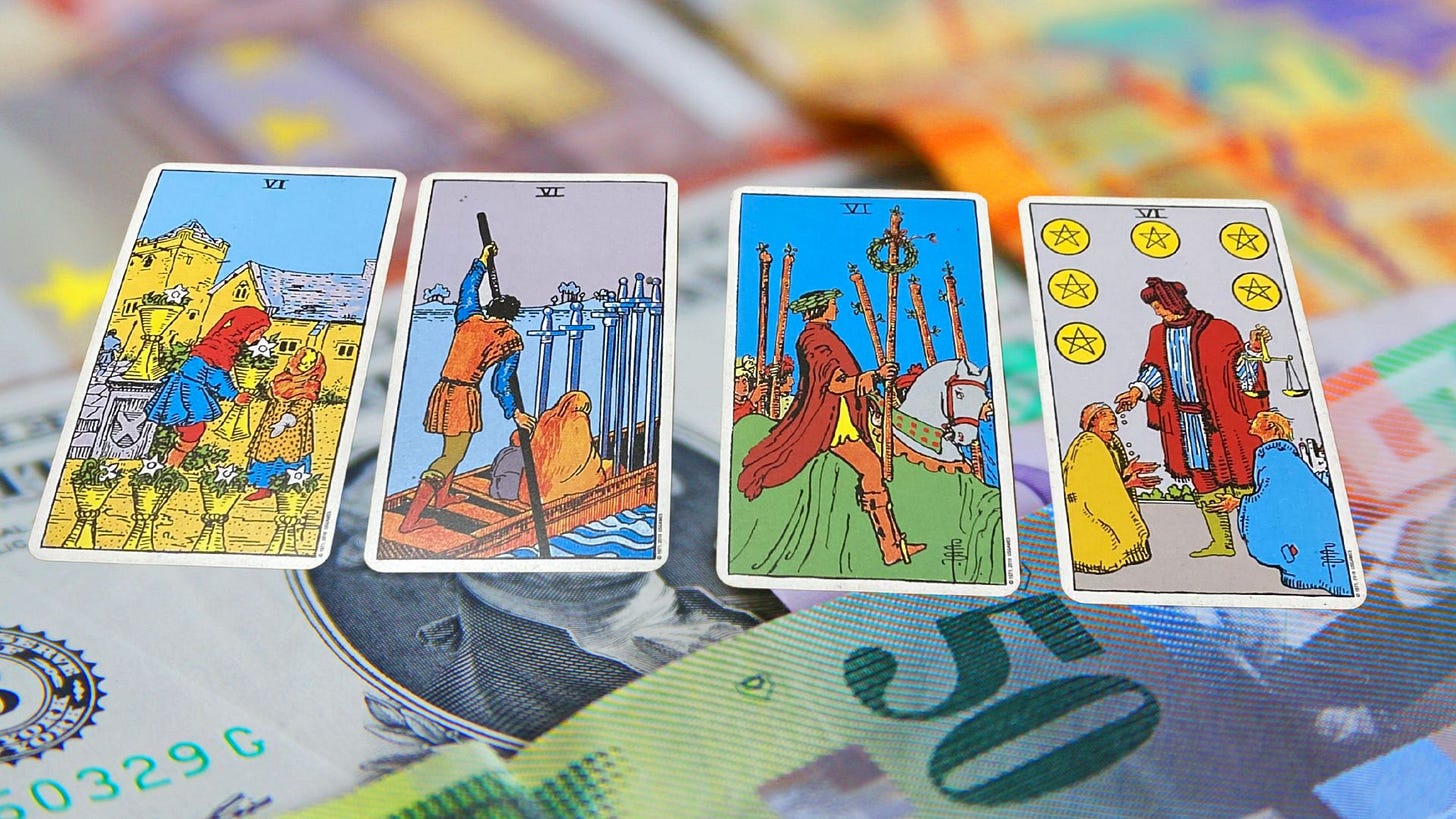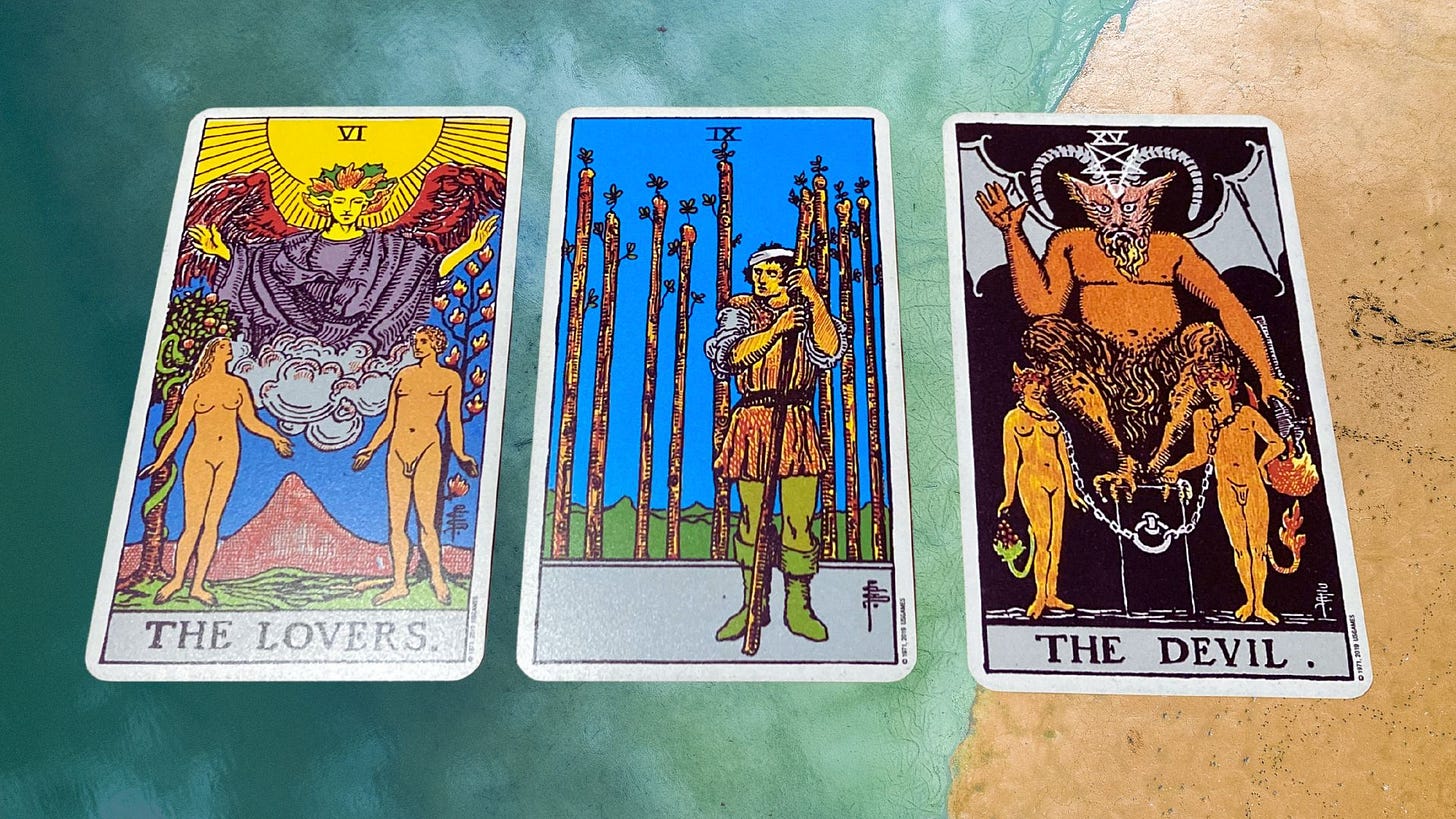Lovers and Devils: Unpacking Saints and Haints in the Shadow of "Sinners"
On Tarot, Twins, and the Tragic Mulatto Narrative
As someone who has always identified as a critic of cultural texts and television, I’ve never been a big fan of going to see films. My preference leans towards narratives that unfold over time, so I often get disappointed when watching something, knowing that once I finish, the story will come to an end. Additionally, I don't think there have been many films that have motivated me to go to the movies. However, since joining Substack, I kept hearing people discuss "Sinners," so I decided to see it on Saturday afternoon.
Even before watching the film, I knew I would enjoy it because I love studying Black cultural texts, and I have a strong connection to rootwork and religion. While watching the movie, I noticed many of these themes, but what stood out most was the use of both literal and figurative chiaroscuro.
Seeing through Shades of Shadow and Light
For those who don’t know, chiaroscuro is a technique that uses shadows and light in filming scenes. If you study film, you know that many filmmakers struggle to effectively use shadow and light in representing Black performers because historically, camera technology was made for white skin. This is why movies like "Moonlight" and even television series like Issa Rae's "Insecure" have received a lot of critical acclaim, as they strike a beautiful balance of using light to draw attention to darker skin tones.
This strategy is even more important within the film "Sinners" because it is a vampire movie with horrific elements. From a literal perspective, if there were too much light, then the film would have been too gory or explicit. From a cultural and psychological perspective, we also know that Black characters and community members are often thrown into the shadow of the white unconscious, making it difficult to view Black people as anything other than positive stereotypes or a subconscious threat.
However, the use of darker lighting allows the audience to have an easier time consuming the content. Similarly, Ryan Coogler does an excellent job of balancing shadow and light in the relationships between the characters and the representation of Black culture and spirituality that has not always been well received in a country that is committed to viewing anything outside of Christianity as demonic.
Like all films with supernatural elements, and even from the title itself, the audience knows that "Sinners" is going to explore the contrast between light and dark, good and evil, religion and spirituality, as reflected through different cultural narratives. But, instead of creating a stark delineation between these two concepts, we see how shadow and light exist within every culture and community, not only through the way lighting is used in the film but also through the significance of the characters.
The Tale of the Twins: Understanding Gemini Energy in Tarot and Astrology
As someone who teaches both tarot and ancestral astrology, one of the first things that stood out to me in the film regarding the representation of shadow and light was that the narrative revolves around the twins, Smoke and Stack, both played by Michael B. Jordan. Coogler notes that the twins are a reference to Yoruba mythology and divine connection. However, in astrology, twins are symbolized by Gemini, while in tarot, the Lovers Card is associated with Gemini.
This card symbolizes duality and divine guidance and is rich in religious symbolism and vibrant imagery. The duality of Gemini strongly aligns with the sign's intellectual capacity, and the Rider-Waite Smith tarot depicts this through the picture of two naked lovers in a lush garden with a fiery and angelic being heralding them from above.
In many ways, this image evokes the story of Adam and Eve in the Garden of Eden, a time before they discovered the truth about the world and their shame. In this sense, the image is more than just a literal reflection of romance. Like Adam and Eve's choice in the garden, the Lovers Card is the ultimate symbol of choice and decision-making in the major arcana.
Throughout the film, this symbolism is reflected in the fact that the twins are individuals who have essentially left the garden of their southern community to escape their shame. On their journey, they gain new knowledge, experience, and understanding of the world by traveling to Germany to fight in a war, as well as by building their wealth and abundance in the northern city of Chicago. As we see early on in the film, many people question what sins they have committed to achieve that success outside the safety of their community.
All of these themes of twins, duality, and religious symbolism also appear in the Outkast song “Aquemini,” as the lyrics state:
“Meet the twin, Andre Ben', welcome to the lion's den
Original skin, many men comprehend
I extend myself, so you go out and tell a friend
Sin all depends on what you believin' in” - Outkast “Aquemini” Lyrics
The song reflects Gemini's themes through the "original sin" depicted in The Lover’s Card—specifically, Adam and Eve’s choice between following God’s word or pursuing knowledge. We see this same choice when Sammie, also known as Preacher Boy, has to decide whether he wants to follow his father's path or play "devil" music.
With Smoke and Stack, we also have moments where they commit acts that would be considered "original sins," such as patricide. However, instead of depicting them as simply evil or two-faced, as Gemini energy is often represented, the audience is prompted to question how life circumstances influence their decision-making.
Similarly, André 3000’s lyrics challenge this narrative by suggesting that sin depends on one's beliefs, offering an alternative interpretation of The Lovers card as less about making a choice and more about the illusion of binary options. From "Sinners", we are prompted to consider that there is more than just good and bad by recognizing how shadow and light are two sides of the same coin that balance each other out, just like the twins.
Narrating Numerology: On The Symbolism of Number Six
In addition to religious symbolism, there is also numerological symbolism in all the tarot cards, with The Lovers card being number six. Symbolically, the number 6 resonates with the vibration of love and care. Other cards with the number 6 throughout the tarot depict images of giving and service, focusing on one person offering something to another. Consequently, the Lover’s Card allows us to reflect on the meaning of love for ourselves and others, focusing on the duality between giving and receiving, as well as the self and the community.
One of the central themes in the film is the relationship between gaining wealth for oneself and giving back to the community. When Smoke and Stack create their juke joint, they must decide whether to prioritize making money for themselves and the business or to create a haven and a place of joy and relaxation for the community.
We see the same decision-making play out when it comes to the types of relationships that the twins pursue. In the past, we see that Smoke was once married to Annie, played by Wunmi Mosaku, a woman who is selflessly committed to her community through her spiritual work. In this sense, she gives assistance and help to others, knowing that what she gives out will be returned to her, not only in material ways but also in intangible ways.
In contrast, we see Stack exhibit more of a capitalistic mindset (even in his name). When it comes to his tumultuous relationship with Mary, played by Hailee Steinfeld, he chooses to chase a check over committing to her. Additionally, his version of protection for her involves ensuring she is in a relationship that provides her with financial security, but this leads to her becoming estranged from her community, thereby lacking the spiritual protection, as well as the emotional and mental stability, that being among her people can offer.
From the Lovers to the Devil: Transforming the Tragic Mulatto Narrative through Tarot
With that said, something that has made me laugh is the criticism surrounding the film, particularly the notion that Mary's character is the villain. I find this to be an interesting perspective because it is clear that the film aims to deconstruct the binary of characters being entirely good or entirely bad. We see that even the devil, Remmick, has a backstory that helps us understand why he became who he is.
But, if you know anything about Black literature or cultural texts, you know that Mary's character is the perfect example of the tragic mulatto narrative. Although I have seen many people argue that Mary is not white-passing and that she is a white woman, we know, historically speaking, that based on the one-drop rule, Mary is an octoroon. For one to be identified as white in the early 20th century, one had to have less than 1/8th Black ancestry to be legally considered white and integrate into white society. So, by that definition, she would have been considered Black.
Generally, tragic mulatto narratives, such as Nella Larsen's "Passing", Tyler Perry's "A Jazzman's Blues", and "Imitation of Life," explore themes of duality and decision-making. These stories often feature light-skinned Black women, traditionally classified as octoroons, who choose to pass as white to achieve social mobility. However, the decision to pass comes with constant struggles regarding identity and belonging.
“Alien can blend right on in wit' yo' kin” - Andre 3000 “Aquemini”
Questions such as "Am I White? Am I Black? Where do I belong? Who is my community? Who is my family?" often arise, so it's ironic that the film raises these same questions in audience members. These stories also tend to focus on the relationships of mixed-race women who try to navigate both racial worlds but often face rejection or violence from one or both communities.
In this sense, I have been thinking about "Sinners" as a vampiric take on the tragic mullatto narrative because it shows how, when someone is passing, they are either damned to exist outside of their community for all eternity or they are doomed to damn others in their community if people find out who they are. Consequently, we see in the end that Mary and Smoke's relationship leads to them both being eternally damned, while Annie and Stack remain lovers in the afterlife.
And we see this dichotomy foreshadowed in the tarot. When you look at the Lovers card, there is a couple united in eternal angelic light, just as Mary and Smoke are together in the heavens with their lost baby. In contrast, the Devil card offers the shadow side of that same pairing, a connection based on an unbreakable tie to darkness. Thus, it is no coincidence that we learn Annie and Stack not only survive as vampires but are eternally denied access to the light of the sun.
“Even the sun goes down, heroes eventually die
Horoscopes often lie and sometimes, "Y"
Nothin' is for sure nothin', is for certain, nothin' lasts forever” - Outkast “Aquemini”
So, even though the twins are separated, their fates still mirror each other in the same way that the Lover's card mirrors the Devil. The film "Sinners" has allowed me to reflect on this consideration of shadow and light, which questions our cultural perception of darkness. I could also write a whole other essay about whether the twins’ relationships are “twin-flame” relationships, but I don’t have the time to write all of that.
In both cases, the couples are no longer living; they are still connected with the person they love, but in very different ways. Therefore, our perception of their outcome is based on how we value the difference between a saint and a haint, reflecting our personal and social beliefs. This begs the question of whether there is a difference between a left or a right-hand path, whether it’s better to be blessed or blooducker, and if so, which is the path for you?







Great read! I think there’s a slight mistake towards the end, it’s Annie and Stack that get reunited in the afterlife and Mary and Smoke that are damned.
I love your analysis! This tracks with my recent understanding of my faith as a Christian… the choice to eat the fruit in the garden of Eden was just that, a choice. With greater awareness comes greater capacity for good and also greater capacity for evil. Everything in our finite earthly existence boils down to one thing- choice.